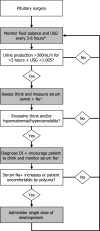Postoperative diabetes insipidus: how to define and grade this complication?
- PMID: 32990908
- PMCID: PMC7966184
- DOI: 10.1007/s11102-020-01083-7
Postoperative diabetes insipidus: how to define and grade this complication?
Abstract
Purpose: Although transient diabetes insipidus (DI) is the most common complication of pituitary surgery, there is no consensus on its definition. Polyuria is the most overt symptoms of DI, but can also reflect several physiological adaptive mechanisms in the postoperative phase. These may be difficult to distinguish from and might coincide with DI. The difficulty to distinguish DI from other causes of postoperative polyuria might explain the high variation in incidence rates. This limits interpretation of outcomes, in particular complication rates between centers, and may lead to unnecessary treatment. Aim of this review is to determine a pathophysiologically sound and practical definition of DI for uniform outcome evaluations and treatment recommendations.
Methods: This study incorporates actual data and the experience of our center and combines this with a review of literature on pathophysiological mechanisms and definitions used in clinical studies reporting of postoperative DI.
Results: The occurrence of excessive thirst and/or hyperosmolality or hypernatremia are the best indicators to discriminate between pathophysiological symptoms and signs of DI and other causes. Urine osmolality distinguishes DI from osmotic diuresis.
Conclusions: To improve reliability and comparability we propose the following definition for postoperative DI: polyuria (urine production > 300 ml/hour for 3 h) accompanied by a urine specific gravity (USG) < 1.005, and at least one of the following symptoms: excessive thirst, serum osmolality > 300 mosmol/kg, or serum sodium > 145 mmol/L. To prevent unnecessary treatment with desmopressin, we present an algorithm for the diagnosis and treatment of postoperative DI.
Keywords: Complications; Diabetes insipidus; Fluid imbalance; Pituitary tumor; Transsphenoidal surgery; Vasopressin.
Conflict of interest statement
The authors report no conflict of interest.
Figures

Similar articles
-
Incidence, clinical manifestations, and course of water and electrolyte metabolism disturbances following transsphenoidal pituitary adenoma surgery: a prospective observational study.J Neurosurg. 2009 Sep;111(3):555-62. doi: 10.3171/2008.9.JNS08191. J Neurosurg. 2009. PMID: 19199508
-
Postoperative water and electrolyte disturbances after extended endoscopic endonasal transsphenoidal surgery.Front Endocrinol (Lausanne). 2022 Aug 23;13:963707. doi: 10.3389/fendo.2022.963707. eCollection 2022. Front Endocrinol (Lausanne). 2022. PMID: 36082073 Free PMC article.
-
Gestational diabetes insipidus: Diagnosis and management.Best Pract Res Clin Endocrinol Metab. 2020 Sep;34(5):101384. doi: 10.1016/j.beem.2020.101384. Epub 2020 Feb 27. Best Pract Res Clin Endocrinol Metab. 2020. PMID: 32205050 Review.
-
Diabetes insipidus.Ann Endocrinol (Paris). 2013 Dec;74(5-6):496-507. doi: 10.1016/j.ando.2013.10.002. Epub 2013 Nov 25. Ann Endocrinol (Paris). 2013. PMID: 24286605 Review.
-
Effectiveness of dietary diabetes insipidus bundle on the severity of postoperative fluid imbalance in pituitary region tumours: A randomized controlled trial.J Adv Nurs. 2021 Sep;77(9):3911-3920. doi: 10.1111/jan.14894. Epub 2021 May 24. J Adv Nurs. 2021. PMID: 34028859 Clinical Trial.
Cited by
-
Change in the pituitary stalk deviation angle after transsphenoidal surgery can predict the development of diabetes insipidus for pituitary adenomas.Endocr Connect. 2022 Oct 14;11(11):e220187. doi: 10.1530/EC-22-0187. Print 2022 Nov 1. Endocr Connect. 2022. PMID: 36103145 Free PMC article.
-
A Novel Magnetic Resonance Imaging-Based Radiomics and Clinical Predictive Model for the Regrowth of Postoperative Residual Tumor in Non-Functioning Pituitary Neuroendocrine Tumor.Medicina (Kaunas). 2023 Aug 23;59(9):1525. doi: 10.3390/medicina59091525. Medicina (Kaunas). 2023. PMID: 37763643 Free PMC article.
-
Increased oxytocin release precedes hyponatremia after pituitary surgery.Pituitary. 2021 Jun;24(3):420-428. doi: 10.1007/s11102-020-01121-4. Epub 2021 Jan 28. Pituitary. 2021. PMID: 33506439 Free PMC article.
-
Diabetes Insipidus after Vasopressin Withdrawal: A Scoping Review.Indian J Crit Care Med. 2022 Jul;26(7):846-852. doi: 10.5005/jp-journals-10071-24244. Indian J Crit Care Med. 2022. PMID: 36864877 Free PMC article.
-
Urinary oxytocin secretion after pituitary surgery, early arginine vasopressin deficiency and syndrome of inappropriate antidiuresis.Endocrine. 2025 Apr;88(1):262-272. doi: 10.1007/s12020-024-04131-5. Epub 2024 Dec 17. Endocrine. 2025. PMID: 39681826 Free PMC article.
References
-
- Araujo-Castro M, Pascual-Corrales E, Martínez San Millan JS, Rebolleda G, Pian H, Ruz-Caracuel I, De Los Santos Granados G, Ley Urzaiz L, Escobar-Morreale HF, Rodríguez Berrocal V. Postoperative management of patients with pituitary tumors submitted to pituitary surgery. Experience of a Spanish Pituitary Tumor Center of Excellence Endocrine. 2020;69:5–17. - PubMed
Publication types
MeSH terms
Substances
LinkOut - more resources
Full Text Sources
Medical

